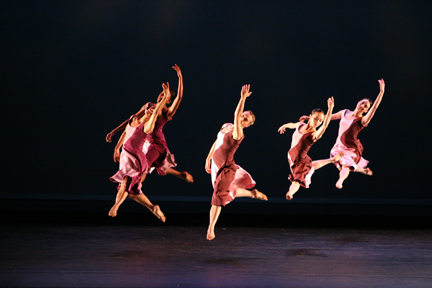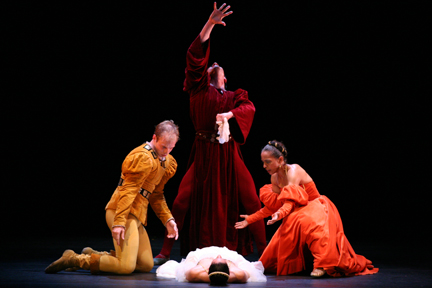Vital history
Limón Dance Company
"A Choreographic Offering," "Lament for Ignacio Sanchez Mejias," "The Moor's Pavane"
The Joyce Theater
New York, NY
November 16, 2006
by Lisa Rinehart
copyright 2006 by Lisa Rinehart
 Attention all choreographers: if you want to get better, go see the Limón Dance Company. The company is thriving 60 years after its founding by José Limón and Doris Humphrey, and thanks to artistic director Carla Maxwell, there's no sign of a slow down. By keeping Limón and Humphrey's work polished, reviving forgotten pieces, and commissioning new works, Maxwell is ensuring that the Limón company remains vibrant for new audiences.
Attention all choreographers: if you want to get better, go see the Limón Dance Company. The company is thriving 60 years after its founding by José Limón and Doris Humphrey, and thanks to artistic director Carla Maxwell, there's no sign of a slow down. By keeping Limón and Humphrey's work polished, reviving forgotten pieces, and commissioning new works, Maxwell is ensuring that the Limón company remains vibrant for new audiences.
Dance historians know the importance of Limón and Humphrey in the lexicon of modern dance, but to see these works performed with loving expertise is revelatory for the average viewer. Humphrey's seriousness of purpose harkens back to a time when modern dance was an antidote for the froo-froo of ballet. Tutus and wigs be damned she proclaimed; dancers were to be the bricks and mortar of a choreographic edifice emblazoned with the title of High Art. For his part, Limón made the making of a dance look effortless (it's not), and reminded us that movement can pack a hefty emotional wallop.
Limón's "A Choreographic Offering" is a perfect case in point. Created in 1964, and set to Bach's A Musical Offering, the dance is a homage to Humphrey. Limón incorporated some of Humphrey's movements and motifs such as hands raised above the head and turned flatly outward, and frequent use of the archaic profile, then added his own elegant fluidity. The dance has the comforting effect of waking to birds chirping outside a country window — no irony, nothing extraneous, just a clean exhilaration with being alive. This is a later piece of Limón's, and one that may have disappeared into the jaundiced haze of the late sixties, but in 2006, it is spectacularly forthright and exuberant. The dancers skim the floor with upper bodies held still and erect, then burst into jumps like airborne swastikas. Legs swoop in graceful spirals as the hands pull into a gently feminine prayer pose by the side of the face. A woman walks into the wings on the helping backs of men that rise to her feet like stones set above the water of a rushing brook. Humphrey's influence on modern dance is palpable as Limón's remembrance conjures Taylor, Graham and Morris. It's a joy to see.
Less effective is the revival of Humphrey's 1949 piece, "Lament For Ignacio Sanchez Mejias," based on the poem by Federico Garcia Lorca. It's about the inevitability of death (in this case, for a bullfighter), and is Humphey at her most heavy-handed. The words of the poem are spoken by two of the dancers, and Humphrey seems to be trying to out serious Martha Graham as the dancers climb over scenery and struggle with uncooperative props. There's not much movement, save for the role of Ignacio (Roel Seeber), whose gangly physique doesn't bring bullfighters to mind. Kristen Foote is formidable as Guardian of Destiny, and Ryoko Kudo as Witness and Mourner is extremely good, bringing pathos to Lorca's florid text. This dance is intriguing because dancers speak as much as move, but somehow the parallel between a bullfighter's courage and the mortality of Everyman feels strained in our graceless age.
 The program closer was Limón's masterwork, "The Moor's Pavane," and it was wonderful to see it performed by dancers trained in the Limón technique. This variation on a theme of Shakespeare's Othello was grittier and less decorous than interpretations I've seen with ballet dancers. Francisco Ruvalcaba was effective, if not quite imposing enough as The Moor, and Roel Seeber was sufficiently nasty as The Friend. The women, however, were very strong; Ryoko Kudo was nuanced and complex as the complicit Friend's Wife, and Roxane D'Orleans Juste was the epitome of soft innocence as the Moor's Wife. It has to be said, however, that it's criminal to perform this piece to taped music. It's simply too good to deny it the depth of live sound — someone please get a grant, or go beg some musicians for a favor!
The program closer was Limón's masterwork, "The Moor's Pavane," and it was wonderful to see it performed by dancers trained in the Limón technique. This variation on a theme of Shakespeare's Othello was grittier and less decorous than interpretations I've seen with ballet dancers. Francisco Ruvalcaba was effective, if not quite imposing enough as The Moor, and Roel Seeber was sufficiently nasty as The Friend. The women, however, were very strong; Ryoko Kudo was nuanced and complex as the complicit Friend's Wife, and Roxane D'Orleans Juste was the epitome of soft innocence as the Moor's Wife. It has to be said, however, that it's criminal to perform this piece to taped music. It's simply too good to deny it the depth of live sound — someone please get a grant, or go beg some musicians for a favor!
Humphrey and Limón are national treasures with immeasurable legacies, but dances don't do well in musty museum companies. Thankfully, as long as the Limón Dance Company is keeping these works alive on stage (and in very fine form, I might add), they will never be relegated to history. The dances will be as formative and important as they have been for the last 60 years, and that is indeed something to celebrate.
Photos, both by Rosalie O'Connor:
"A Choreographic Offering."
"The Moor's Pavane."
Volume 4, No. 41
November 20, 2006
copyright ©2006 Lisa Rinehart
www.danceviewtimes.com